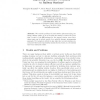Free Online Productivity Tools
i2Speak
i2Symbol
i2OCR
iTex2Img
iWeb2Print
iWeb2Shot
i2Type
iPdf2Split
iPdf2Merge
i2Bopomofo
i2Arabic
i2Style
i2Image
i2PDF
iLatex2Rtf
Sci2ools
106
Voted
CIAC
2003
Springer
2003
Springer
Improving Customer Proximity to Railway Stations
Abstract. We consider problems of (new) station placement along (existing) railway tracks, so as to increase the number of users. We prove that, in spite of the NP-hardness for the general version, some interesting cases can be solved exactly by a suitable dynamic programming approach. For variants in which we also take into account existing connections between cities and railway tracks (streets, buses, etc.) we instead show some hardness results. 1 Models and Problems There are many instances when public or private sector bodies are faced with making decisions on how to allocate facilities optimally. Such problems with mathematically quantifiable optimization constraints have been studied extensively in the scientific literature (e.g., see the book [3]). Recently the European Union has been encouraging the privatization of railway assets in various EU countries in order to improve system efficiency as well as customer satisfaction. In this paper we approach one such problem by study...
| Added | 06 Jul 2010 |
| Updated | 06 Jul 2010 |
| Type | Conference |
| Year | 2003 |
| Where | CIAC |
| Authors | Evangelos Kranakis, Paolo Penna, Konrad Schlude, David Scot Taylor, Peter Widmayer |
Comments (0)

